ISSN ONLINE(2319-8753)PRINT(2347-6710)
ISSN ONLINE(2319-8753)PRINT(2347-6710)
| Nmegbu, Chukwuma Godwin Jacob Ph.D Candidate, Department of Petroleum Engineering, Rivers State University of science and technology, Rivers State, Nigeria |
| Related article at Pubmed, Scholar Google |
Visit for more related articles at International Journal of Innovative Research in Science, Engineering and Technology
The performance of any EOR technique puts into critical consideration the reservoir geology, lithology, reservoir uniformity, pay continuity and a wide range of other rock properties. This multi-mechanism, environmental friendly and inexpensive biotechnological approach to oil recovery (MEOR) must also put into consideration the formation characteristics for an effective and productive microbial injection project. This study tends to ascertain numerically the effects of formation matrix on the performance of MEOR by presenting a mathematical model accounting for microbial concentration distribution for various formation types. Results showed that for a homogenous reservoir, the average microbial concentration in the reservoir increased linearly with increasing days of microbial injection. Variation of porosity and permeability in heterogeneous reservoir yielded a non-linear relationship as a result of the varying rock properties when averaging method of permeability and porosity was adopted. A non-averaged permeability and porosity deduction for a heterogeneous formation will result in a more distorted concentration profile of the injected microbes. An irregularity in concentration distribution of microbes in these heterogeneous reservoirs is traceable to the distorted propagation and transportation of these injected microbes.
Keywords |
| Formation, Heterogeneous, Homogeneous, Matrix, MEOR, Microbes |
I. LITERATURE SURVEY |
| The rock properties and their variations from one location to another significantly influence MEOR performance and ultimately the oil recovery [6]. Fredrickson et al presented experimental results on pore-size constraints on the activity and survival of the subsurface bacteria using different grain size of the medium to high permeability [4], [7]. The microbes were investigated in fractured porous media using etched-glass micro-models [8]. [8] also used non fracture models to compare the efficiency of MEOR in fraction and non-fracture porous media. Among their considerations were the choice of microbes limited to Bacillus substilis (a biosurfactant producing microbe) and leuconostocmesenteroides (an exopolymer producing microbe). Their result showed that higher oil recovery efficiency will be achieved by using a biosurfactant producing bacteria in fractured porous media. The presentation of five successful MEOR projects was reported in [9]. These projects reflected diversity of locations, depth, porosity, permeability and temperatures which were conducted in different parts of the world. The projects included sandstone, fractured dolomite and fractured sandstone reservoirs. Reservoir depth ranged from 4450 to 6900ft, temperatures from 110oF to 180oF, porosity range from 0.079 to 0.232 and effective permeability from 17 to 300mD. Analysis of the above showed that MEOR recovers oil and reduced water production from highly permeable zones. |
| The discovery of soil samples to permeate fluid in different rates depending on the characteristics of the medium through which fluid flows was presented in [10]. He presented mathematically the rate at which fluid flows directly proportional to the area of the media through which the fluid is flowing. He outlined that for a MEOR performance, some properties are of great importance which includes; reservoir geometry, depth, pay uniformity and continuity, formation transmissibility, formation storage capacity and oil viscosity. The performance of a MEOR project and penetration of microbes through the formation greatly depends on formation orientation and rock grain arrangement in the reservoir. Plugging and clogging of the formation are some of the frequently encountered risks in MEOR application, the analysis of these effects on fluid flow, microbial concentration profile and production rates of recoverable oil forms the basis of this study |
II. INTRODUCTION` |
| Conventional oil recovery methods cannot recover all of the oil in the reservoir when the reservoir has fully depleted its primary energy drive. Hence the need for microbial enhanced oil recovery (MEOR) which is a sophisticated technique meant for recovering high viscosity crude in the reservoir. Microbial enhanced oil recovery usually termed oil biorefining and biodegradation results in recovering heavier oil due to is viscosity reduction effects, volume displacement, surface tension reduction, acid reaction, increased permeability, improved sweep efficiency and increased reservoir pressure [1], [2]. The matrix of a reservoir formation consists of organic and inorganic materials that are under compaction in a reservoir [3], [4]. It is also the arrangement of grains in the formation, consisting of organic and inorganic materials that are under compaction in a reservoir [4], [5].The arrangement of the rock grains determines the permeability, porosity, inter-connectivity, tortuosity and fluid saturation of the formation. |
III. RESEARCH METHODOLOGY |
| The mathematical model to be proposed for demonstrating bacteria transportation through porous media is based on a combination of the theories proposed by Gruesbeck et al [11] for description of entrainment and deposition of fines in porous media |
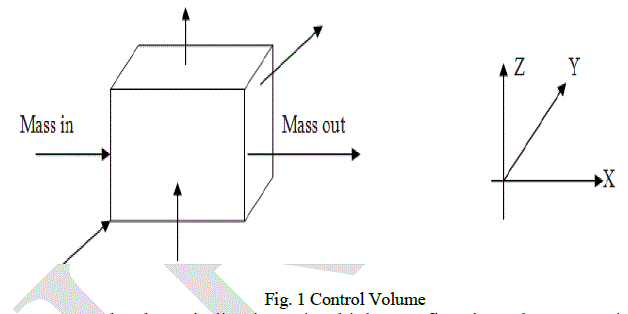 |
 |
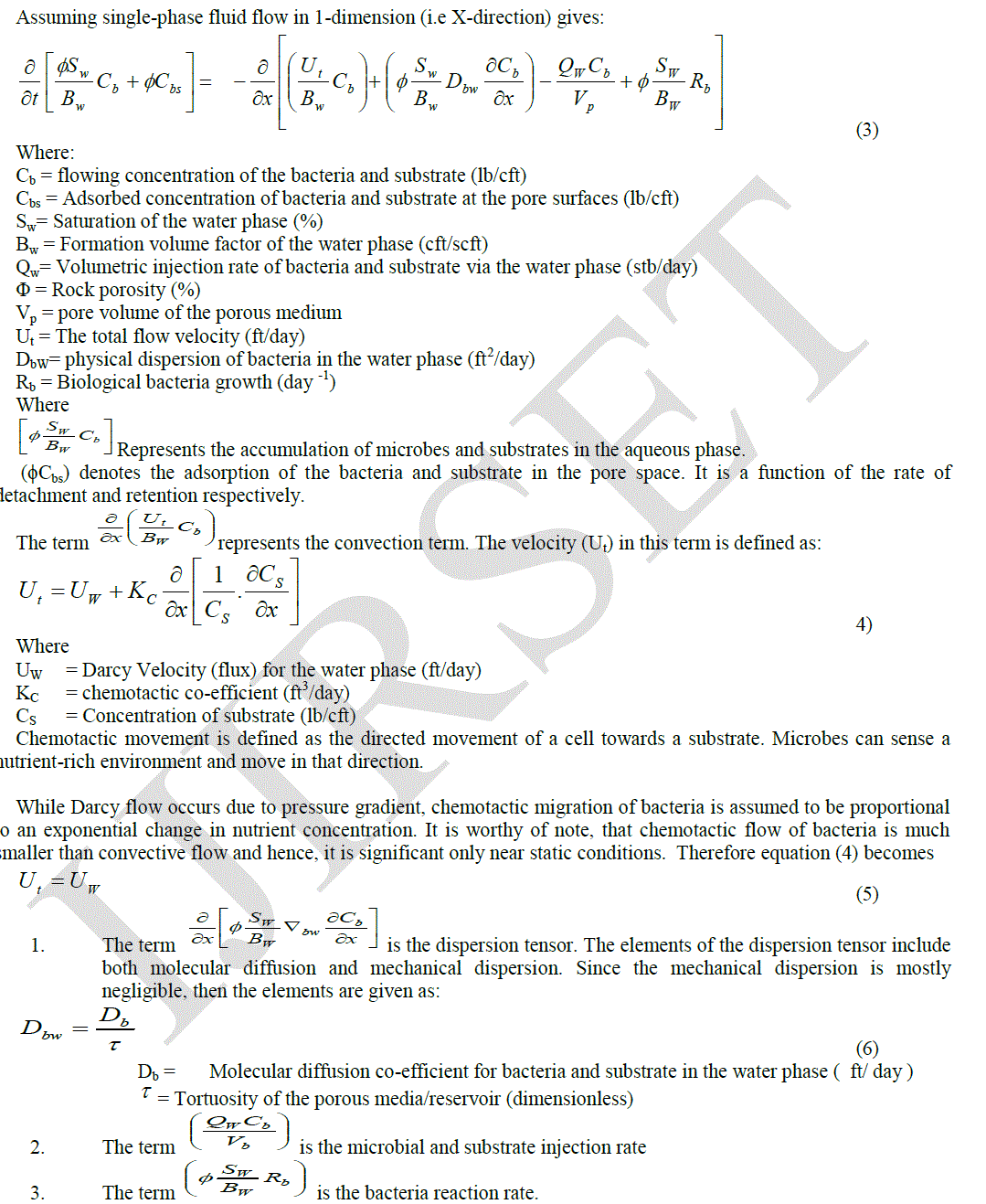 |
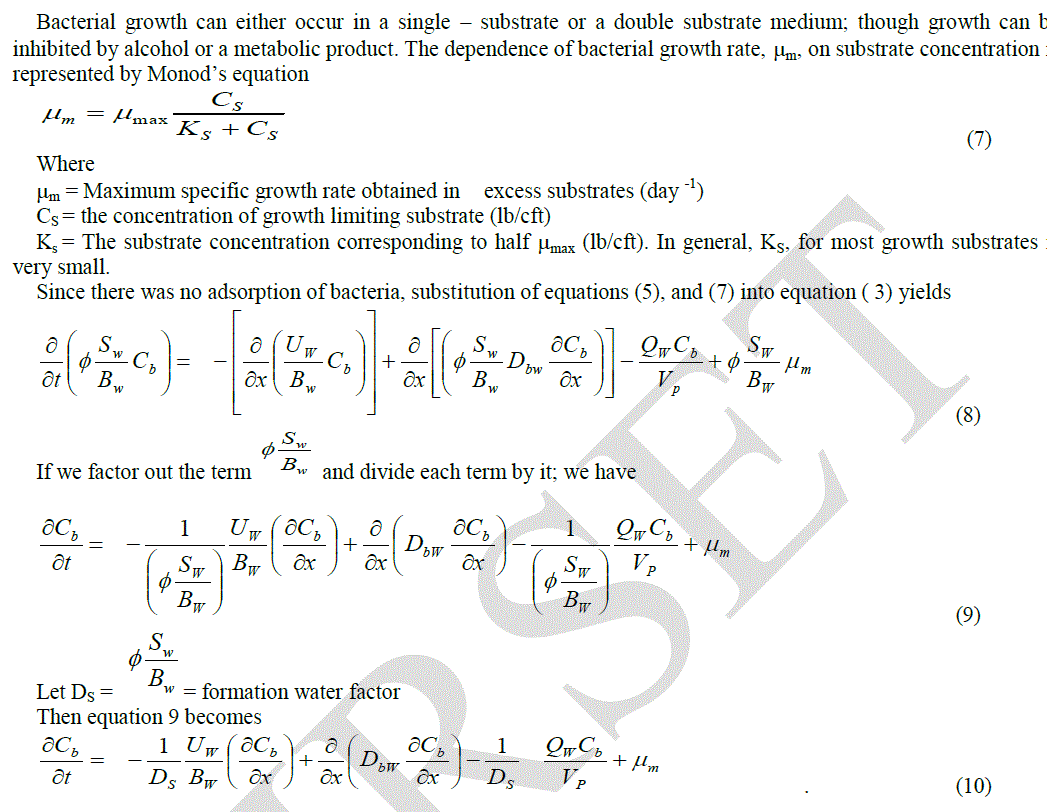 |
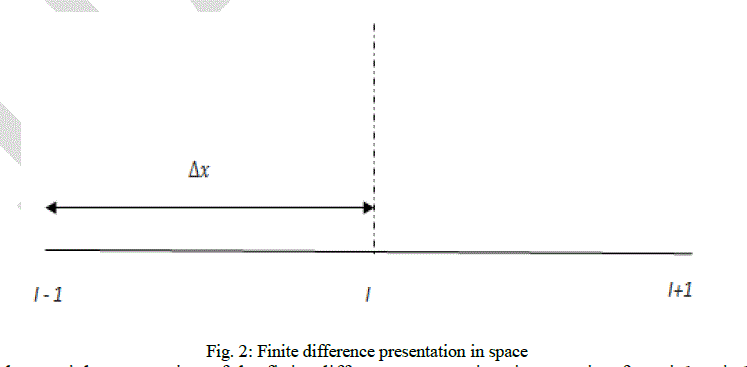 |
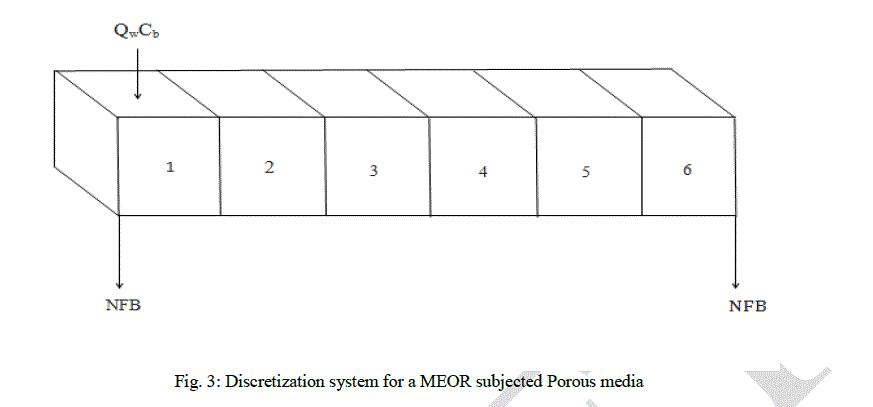 |
| Fig. 3 illustrates a block centered grid system which was selected for the finite difference formulation. The X and Y directions are the areal coordinates and the positive z-direction is normal to the bedding plane in the downward direction. The blocks are numbered in natural order. |
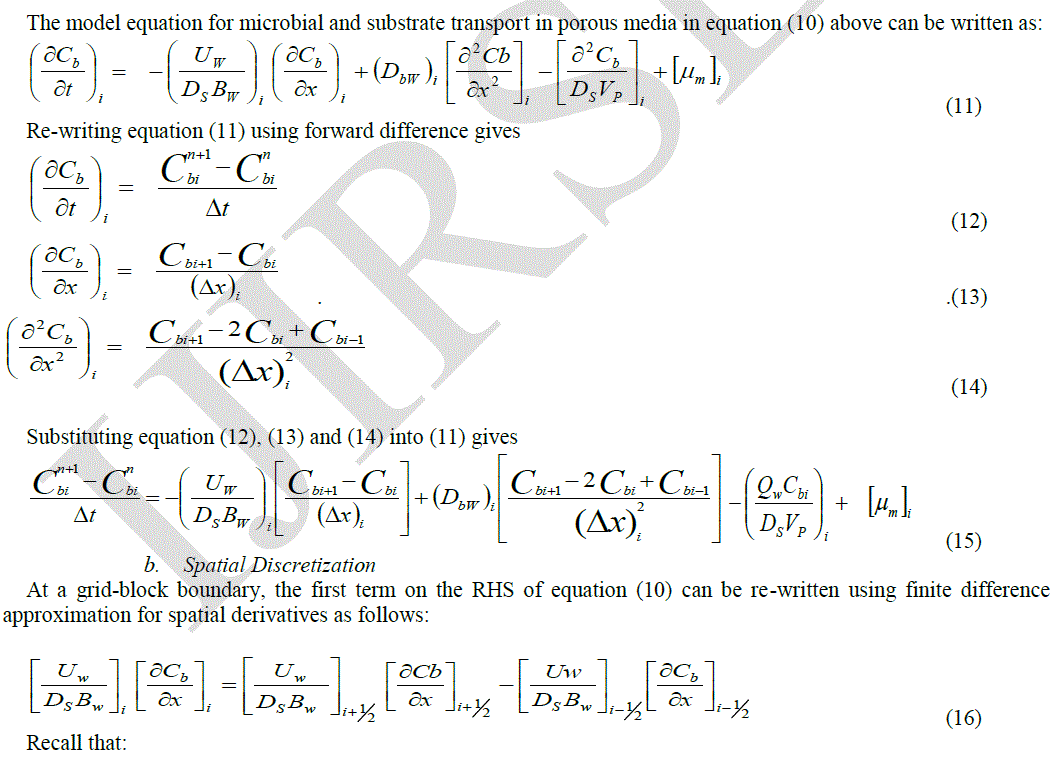 |
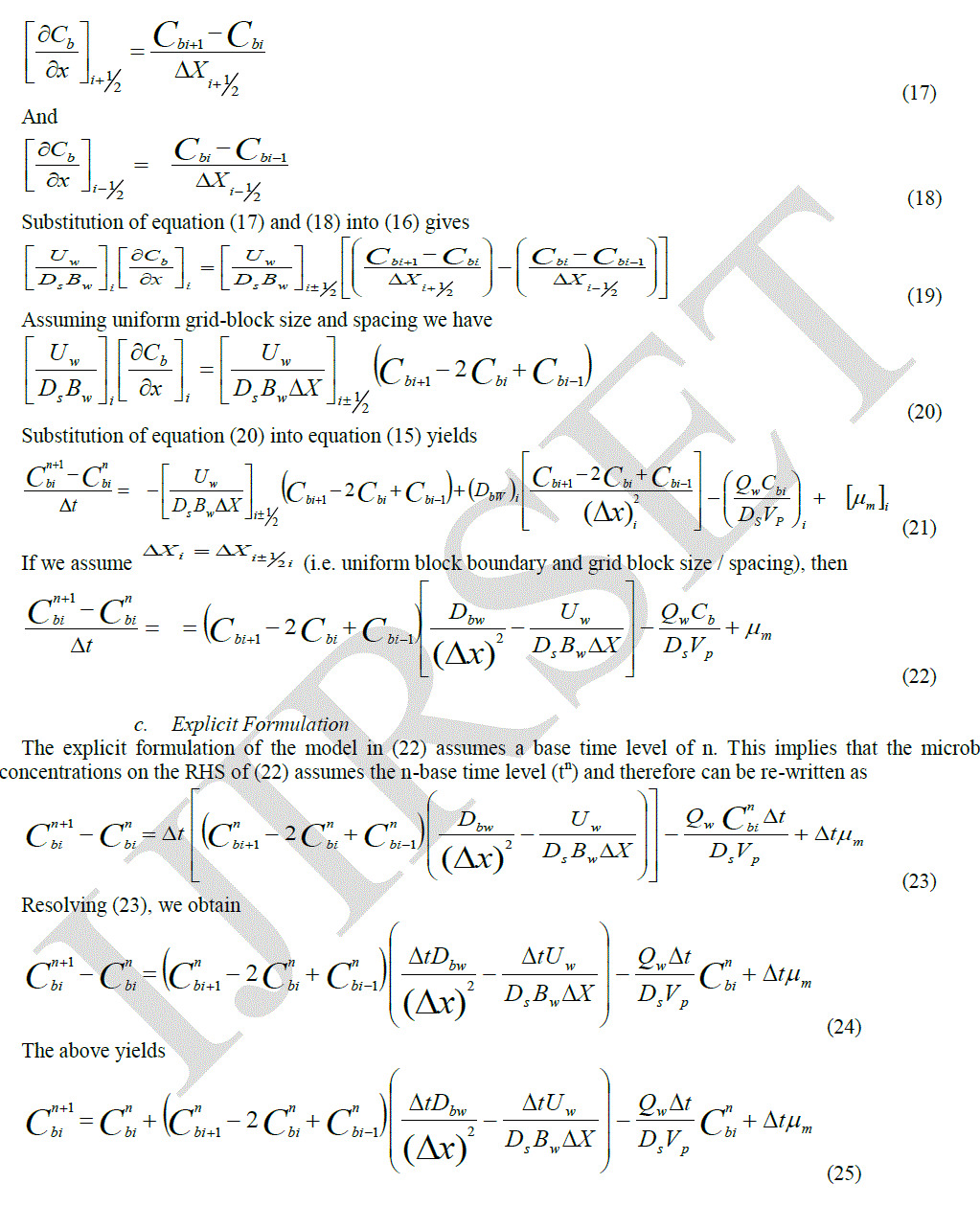 |
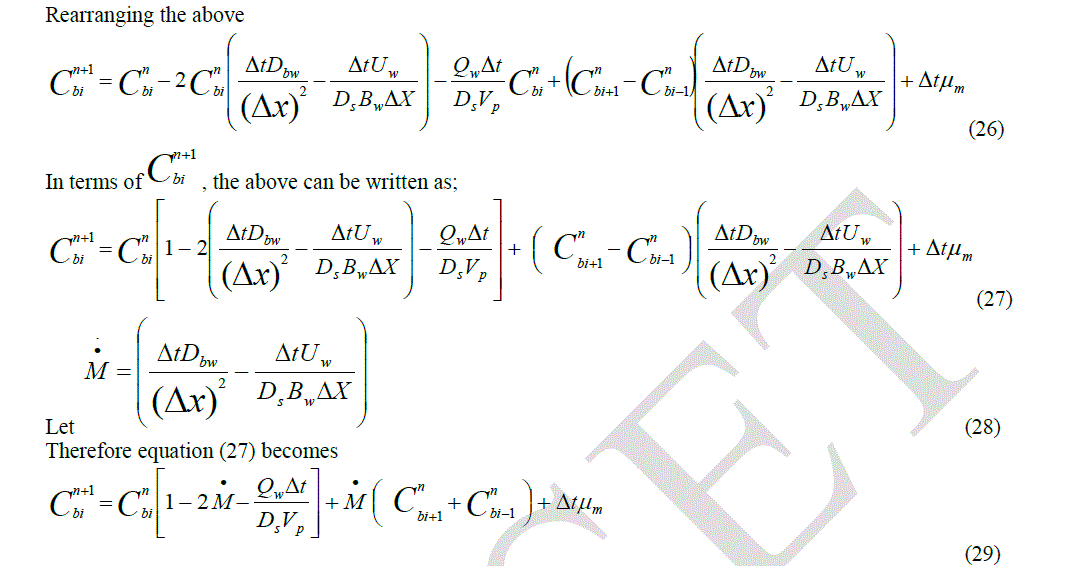 |
| The following assumptions were made in deriving the deduced model: |
| 1) The bacteria and substrate were transported into the reservoir via the water phase. |
| 2) There was no external production during the period of microbial injection. |
| 3) There was no adsorption of bacteria on the pore spaces during propagation and therefore bacterial rates for retention and detachment were to considered |
| 4) Minimal substrate metabolites production |
| 5) Change sin porosity (Ø) phase saturations (Sw) and formation volume factors (Bw) were small compared to changes in concentrations. |
| 6) Chemo-taxis. Not considered |
| 7) Effects of mechanical tensor were negligible. |
| 8) Gravitational effects were neglected. |
| 9) Microbial injection and transportation occurred in a homogenous and isotropic reservoir ( porous media) i.e. K = constant at constant velocity ( Uw) |
| 10) Area of microbial flow in porous media is constant. |
| 11) There was no microbial influx at boundaries during propagation. |
| 12) Other factors affecting MEOR such as salinity and pH were not considered. |
| 13) No specific microbial consideration |
IV. RESULTS AND DISCUSSION |
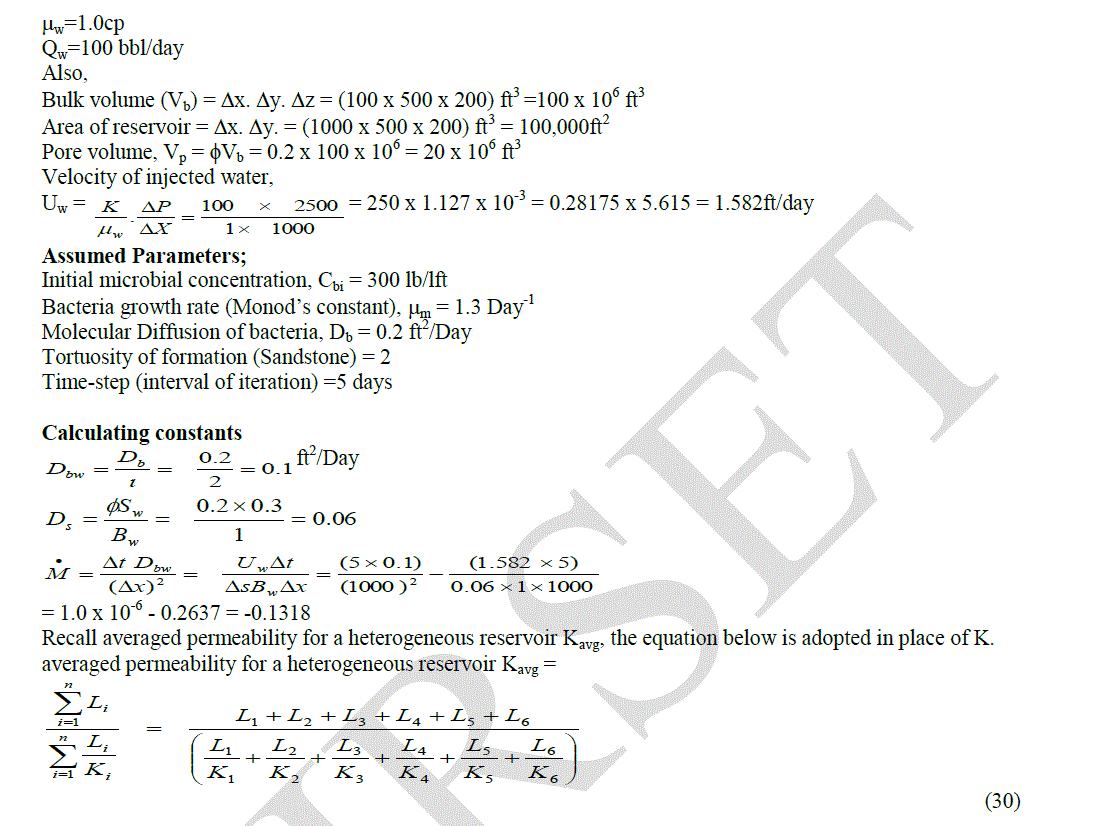 |
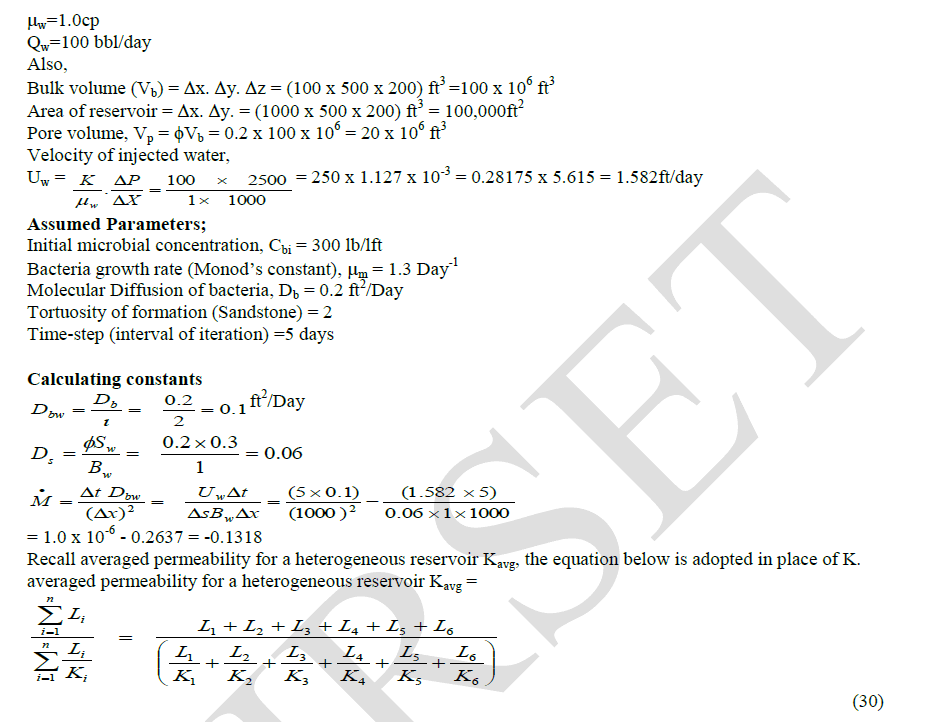 |
 |
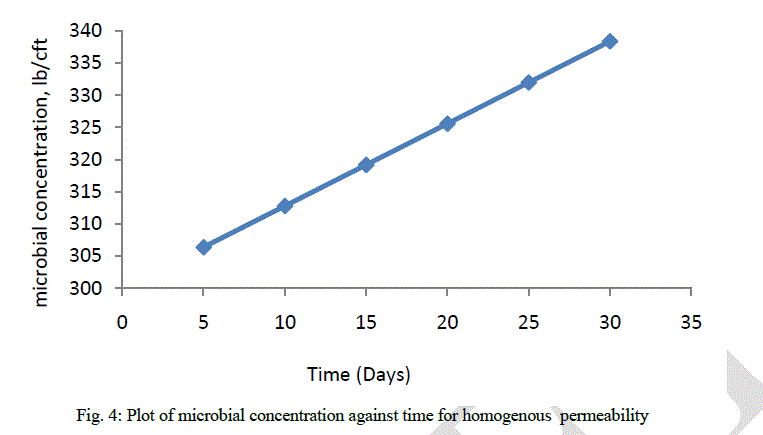 |
| Fig. 4 shows a plot of average microbial concentration against time in Fig. 4 gives a straight line. The implication of this is that for a homogenous reservoir system having constant permeability and porosity, there is a constant increase in biomass concentration at every point in time. Since the formation matrixes are uniformly arranged, transportation of microbes were not breached, distorted or impeded. This results in a steady and defined transportation of the injected microbes |
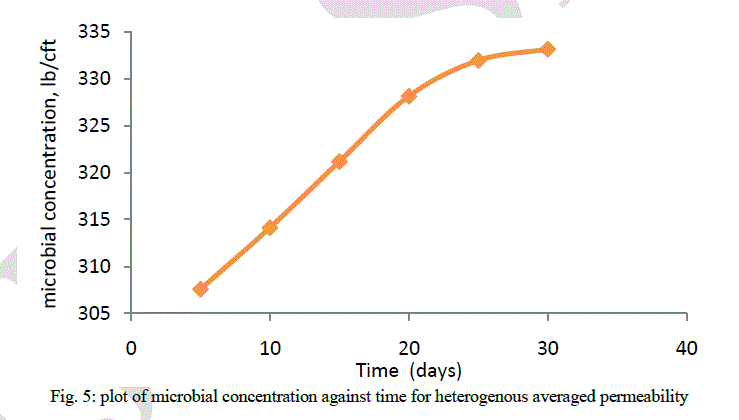 |
| Fig. 5 presents the response of the concentration of microbes with increasing time for a heterogeneous reservoir system, adopting the averaging method for porosity and permeability. It is observed that for varying formation matrix parameters such as porosity and permeability, the microbial concentration profile is distorted. Therefore the average microbial concentration trend with increasing time will not be uniform as seen for the homogeneous system. |
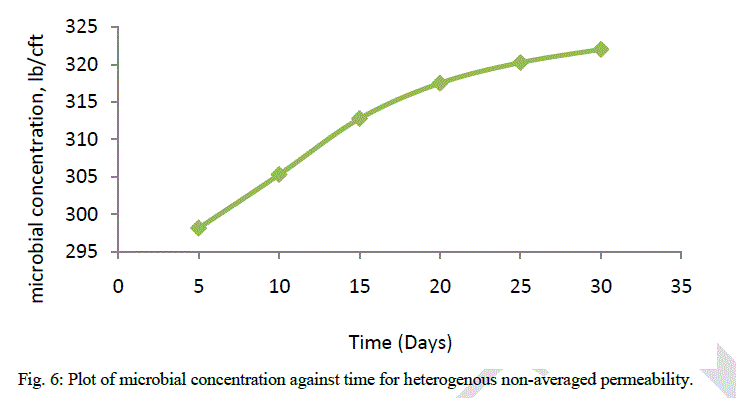 |
| Biomass concentration per unit time was also calculated for heterogeneous reservoir whose varying rock parameters without adopting the averaging method for porosity and permeability. The inconsistencies observed in the plots of concentration against time with different porosity and permeability is shown in Fig 6. A reduction in the values of microbial concentration was observed as microbes moved across the reservoir grid blocks form injector well to the producer, traceable to the clogging tendency of the microbes as they meander through the formation. The above phenomenon will result in an inefficient microbial oil recovery process. |
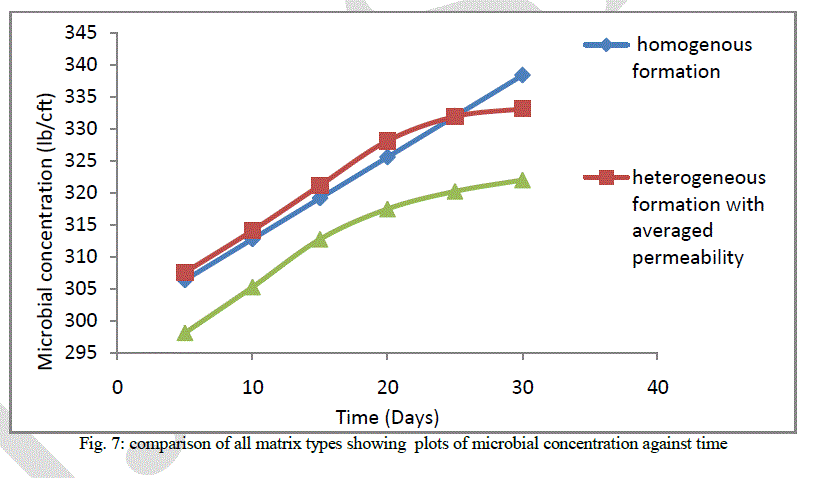 |
| A comparison of concentration of the injected microbes with respect to injection time is presented for homogeneous, heterogeneous and heterogeneous Averaged permeability in Fig 7. Both heterogeneous formations appear to follow the same trend, but the non-averaged permeability formation recorded a lower microbial concentration over the injection period. |
V. CONCLUSION |
| MEOR is almost applicable to any type of reservoir with respect to their depositional characteristics, reservoir configuration, bed arrangement etc.Adaptation of the averaging method for both permeability and porosity will minimize the degree of distortion in the concentration profile of the injected microbe. The performance efficiency of MEOR will be higher in magnitude for a homogenous reservoir as when compared to the performance of MEOR for Heterogeneous reservoirs, irrespective of the adaptation of the averaging method for the rock properties. It is understood that variation in rock properties such as porosity and permeability will significantly determine the transport, mobility, propagation, performance and efficiency of the MEOR process. |
ACKNOWLEDGEMENT |
| The Author highly appreciates the efforts of Ezeanya Obinna and Pepple Daniel Dasigha for the fruitiness of this study |
References |
|